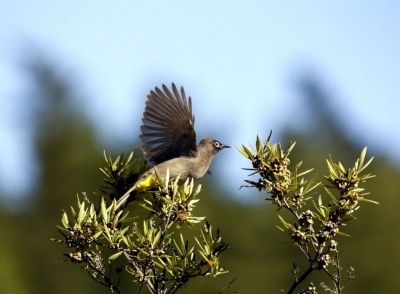(Attempt to disguise some copied text. Photo caption. References) |
(Open-winged picture added. Reference updated) |
||
| Line 7: | Line 7: | ||
The white eye-ring distinguishes this species from the similar [[Dark-capped Bulbul]] and [[Black-fronted Bulbul]]. | The white eye-ring distinguishes this species from the similar [[Dark-capped Bulbul]] and [[Black-fronted Bulbul]]. | ||
==Distribution== | ==Distribution== | ||
| + | [[Image:Cape bulbul2.jpg|thumb|400px|right|Photo by {{user|xmesox|xmesox}}<br />Somerset West, [[South Africa]], April 2011]] | ||
Endemic to southern and south-western Cape Province ([[South Africa]]). | Endemic to southern and south-western Cape Province ([[South Africa]]). | ||
==Taxonomy== | ==Taxonomy== | ||
| Line 20: | Line 21: | ||
The cup-shaped, thick walled nest is formed inside the foliage of a small tree or shrusb. | The cup-shaped, thick walled nest is formed inside the foliage of a small tree or shrusb. | ||
==References== | ==References== | ||
| − | #{{Ref- | + | #{{Ref-Clements6thDec10}}#birdlife.org.za |
#BF member observations | #BF member observations | ||
{{ref}} | {{ref}} | ||
Revision as of 23:08, 30 April 2011
- Pycnonotus capensis
Identification
Size 19-21 cm
An all-brown bird, with a distinctive white eye-ring, and yellow vent.
Similar Species
The white eye-ring distinguishes this species from the similar Dark-capped Bulbul and Black-fronted Bulbul.
Distribution
Endemic to southern and south-western Cape Province (South Africa).
Taxonomy
This is a monotypic species[1].
Habitat
Coastal scrub, riverine forests, exotic plantations and gardens.
Behaviour
Usually seen in pairs or small noisy groups. Inclined to sit at the top of a bush.
Diet
They eat fruit, nectar and insects.
Breeding
Nesting season September to November.
The cup-shaped, thick walled nest is formed inside the foliage of a small tree or shrusb.
References
- Clements, JF. 2010. The Clements Checklist of Birds of the World. 6th ed., with updates to December 2010. Ithaca: Cornell Univ. Press. ISBN 978-0801445019. Spreadsheet available at http://www.birds.cornell.edu/clementschecklist/Clements%206.5.xls/view
- birdlife.org.za
- BF member observations
Recommended Citation
- BirdForum Opus contributors. (2024) Cape Bulbul. In: BirdForum, the forum for wild birds and birding. Retrieved 21 May 2024 from https://www.birdforum.net/opus/Cape_Bulbul





